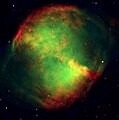File:M27 - Dumbbell Nebula.jpg
Appearance

Size of this preview: 600 × 599 pixels. Other resolutions: 240 × 240 pixels | 480 × 480 pixels | 769 × 768 pixels | 1,025 × 1,024 pixels | 2,044 × 2,042 pixels.
Original file (2,044 × 2,042 pixels, file size: 1.74 MB, MIME type: image/jpeg)
File history
Click on a date/time to view the file as it appeared at that time.
| Date/Time | Thumbnail | Dimensions | User | Comment | |
|---|---|---|---|---|---|
| current | 18:14, 25 August 2022 |  | 2,044 × 2,042 (1.74 MB) | Fabian RRRR | from the actual source |
| 08:34, 2 March 2010 |  | 4,961 × 5,004 (3.04 MB) | Tryphon | Higher resolution, from http://www.eso.org/public/archives/images/large/eso9846a.jpg. | |
| 09:02, 18 September 2008 |  | 3,966 × 4,000 (849 KB) | Lars Lindberg Christensen | {{Information |Description={{en|1=The Dumbbell Nebula - also known as Messier 27 or NGC 6853 - is a typical planetary nebula and is located in the constellation Vulpecula (The Fox). The distance is rather uncertain, but is believed to be around 1200 light |
File usage
The following 2 pages use this file:
Global file usage
The following other wikis use this file:
- Usage on af.wikipedia.org
- Usage on ar.wikipedia.org
- Usage on arz.wikipedia.org
- Usage on ast.wikipedia.org
- Usage on az.wikipedia.org
- Usage on bs.wikipedia.org
- Usage on ca.wikipedia.org
- Usage on ckb.wikipedia.org
- Usage on cs.wikipedia.org
- Usage on de.wikipedia.org
- Usage on el.wikipedia.org
- Usage on en.wikipedia.org
- Usage on es.wikipedia.org
- Usage on et.wikipedia.org
- Usage on eu.wikipedia.org
- Usage on fi.wikipedia.org
- Usage on fr.wikipedia.org
- Usage on fr.wikibooks.org
- Usage on he.wikipedia.org
- Usage on hu.wikipedia.org
- Usage on id.wikipedia.org
- Usage on it.wikipedia.org
- Galassia di Andromeda
- Galassia del Triangolo
- Nebulosa di Orione
- Nebulosa Granchio
- Catalogo di Messier
- Galassia Virgo A
- M4 (astronomia)
- Ammasso Farfalla
- M7 (astronomia)
- Nebulosa Laguna
- M11 (astronomia)
- Galassia Sombrero
- Nebulosa Trifida
- Nebulosa Manubrio
- Nebulosa Anello
- Galassia Occhio Nero
- Galassia di Bode
View more global usage of this file.

